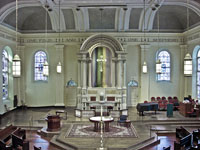Chair of the Board: Edward Dunn III
Vice-Chair: Michael Kelly
Secretary: Colleen McCahill
Contact: Parish Office: 410-962-5078
St. Vincent de Paul Parish was founded in 1840 and one year later opened its doors to its first worshipers in the only church building this parish has ever had, making it the “oldest continuously-operating Catholic parish church in Baltimore.”
In 1979, the church was listed on the National Register of Historic Places. A separate corporation, St. Vincent de Paul Church Historic Trust, Inc, was established to create and manage an endowment to preserve the historic fabric of the building. The pastor, pastoral associate, President of the Parish Council and Chair of the parish Finance Committee are ex officio members of the Board of the Trust, with six further members drawn from the financial management and historic preservation communities of Baltimore.
Funds generated from the interest on this endowment are available for the renovation and structural maintenance of the historic buildings. The Board meets annually, with the officers of the Board consulting as necessary in the interim, calling semi-annual meetings as needed. The Trust undergoes an annual independent audit.
Projects funded in whole or part by the Historic Trust include:
- Exterior renovation of the bell tower and replacement of the gold-leafed cross atop it.
- Re-setting and mortaring the granite front steps of the church, and stabilization and maintenance of the stone piers that support the steps.
- Preservation (in multi-year phases) of the church’s 18 historic windows.
- Restoration and preservation (in multi-year phases) of the exterior walls of the church.
- Interior rectory renovations towards accessibility standards.
- Interior re-pointing of the bell tower.
- Masonry restoration of exterior sacristy walls, park retaining wall, and brick piers supporting historic iron gates.
- Repair, maintenance, and re-coating of the church’s standing-seam metal roof.
- Repointing of stone foundation walls (interior and exterior), and the stone cheek walls of the church’s front steps.

